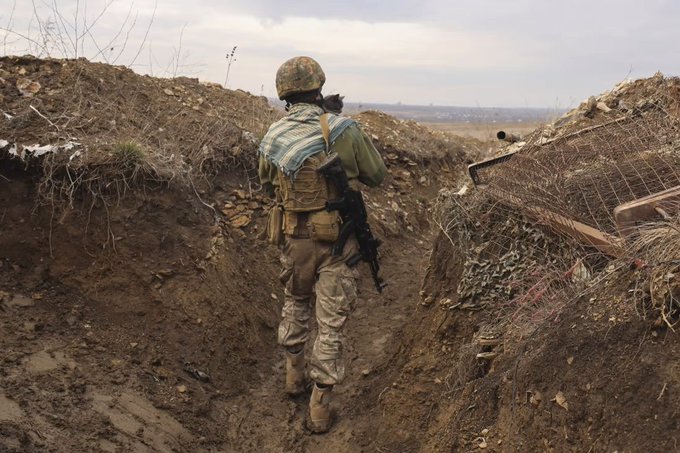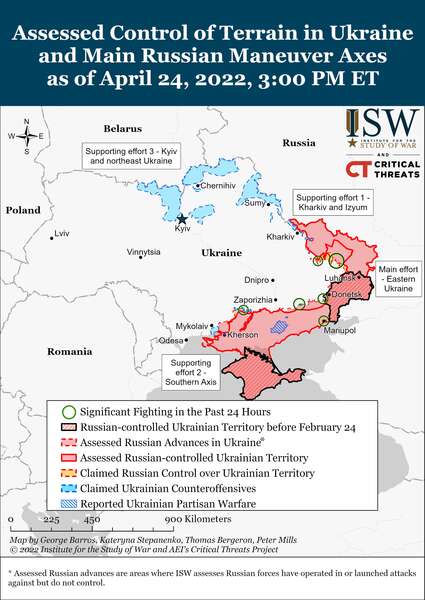Judging by the statements from Moscow , Russia seems in Ukraine to follow the same playbook as in Syria. After a 'withdrawal' Russian and Syrian forces focused their offensives at one target at a time. Once the Donbas is captured the Russian army could start an offensive on Kharkiv, and then on the South. If Ukraine has to sustain a war of attrition, it needs to rely on Western support. Europeans must prepare for the long war, argues Gustav Gressel for the European Council of Foreign Affairs.
 Ukrainian soldier in a trench in the Donbas. Photo from twitter
Ukrainian soldier in a trench in the Donbas. Photo from twitter
by Gustav Gressel
On 29 March, Russia’s deputy defence minister, Alexander Fomin, announced that his country’s forces would scale back their military activity around Kyiv and Chernihiv and concentrate instead on the 'liberation' of the Donbas region. Indeed, the Russian army ceased to advance; its troops prepared defensive positions and partially withdrew. But the Ukrainians seized the moment and attacked, routing Russian positions north and east of Kyiv. Thereafter, Russian forces withdrew completely from positions west of Kharkiv.
And so a new offensive now begins in Donbas. Russia has pulled together new forces from all across the country, including exposed territories such as its exclave of Kaliningrad on the Baltic Sea. Forces previously used around Kyiv and Sumy are still in the process of regrouping and re-equipping, and may join this offensive at a later stage.
Militarily, fighting in Donbas provides advantages for Russia. Trying to advance along too many axes – Kyiv, Sumy, Kharkiv, Donbas, Kherson, Zaporizhia – at the same time has thinned out Russian forces. On none of these fronts have they been able to achieve decisive superiority in strength and firepower. Russian supply lines became over-stretched and hard to defend against Ukrainian ambushes. In Donbas, supply lines are shorter, the rail network is denser, and the proxy republics that Russia controls provide security for the rear. It therefore seems logical to try to wear away and defeat Ukraine’s armed forces in this part of the country rather than around Kyiv.
Peace negotiations are far off
But does this mean that the conquest and eradication of Ukraine is off the table? Does it mean Vladimir Putin would be willing to make peace if he captures Donbas in its entirety? It does not.
Recent statements issued by the Russian Ministry of Defence and General Staff describe the aim of military operations in the coming weeks, but their contents do not reflect the true political goals. And Putin himself recently vowed to carry on the invasion until the 'the goals set initially are completed', which includes destroying Ukraine as a nation. And Russia made no reaction when European Commission president Ursula von der Leyen announced the acceleration of Ukraine’s European Union accession process: if Moscow had accepted some sort of free Ukraine as an inevitable fact, it would have protested by all means available.
In this light, Russia’s withdrawal from Kyiv looks to be a temporary affair. To minimise its own losses and maximise those of Ukraine, Russian offensives are now concentrated in one direction at a time. For now, this is Donbas. Seizing this region would then improve Russia’s ability to launch – after another pause to regroup – an offensive on the city of Kharkiv in the summer. After that, it could resume the offensive from the southern city of Kherson either northwards or eastwards. Rather than taking territory, achieving a more favourable attrition rate (in terms of the ratio of Ukrainian and Russian losses) could be key to determining success or failure for the Russian armed forces. Moscow can sustain the war militarily and economically. It may well last years.
Putin himself recently vowed to carry on the invasion until 'the goals set initially are completed', which includes destroying Ukraine as a nation
In Syria, Russia’s initial attempts to quickly advance along many axes also met with little success. So, in a move intended to deceive opponents, Putin announced a withdrawal of Russian forces from Syria in March 2016. Russian and Syrian troops from then on focused their offensives on one target at a time, concentrating first on Palmyra, then Aleppo, then the eastern and central regions, and finally turning north to Idlib. Setting clear operative priorities and conquering one region at a time, Russia decisively expanded the territory controlled by Bashar al-Assad after a 'withdrawal' that heralded merely an operational pause.

Syrian playbook
Russia now appears to be following the same playbook in Ukraine. Its forces have proved incapable of sustaining fast and deep operations, but they still can win a slow war of attrition. Over the past three weeks, Russian ballistic and cruise missile attacks have systematically attacked Ukraine’s defence industry, as well as oil depots and refineries. The first degrades Ukraine’s ability to produce ammunition and sustain its armed forces, making it more dependent on the West; the second restricts the mobility of Ukraine’s mechanised reserves.
If Ukraine has to sustain a war of attrition, it will need to rely on the West’s support. But here comes the tricky part. Because the Ukrainian armed forces are only familiar with Soviet systems, the West is able just to provide Soviet legacy equipment, which is still present in the stocks and arsenals of some central and eastern European armies. Such assistance can have an immediate effect, but only for a limited time: not all such systems are available in the numbers Ukraine needs, while ammunition supply is difficult because few factories are making ammunition for systems these armies had been planning to phase out. Training Ukrainian crews and servicemen to handle Western equipment takes time. But ultimately this is inevitable, because these are the only systems whose entire supply chains Western powers control on a sustainable basis.
Planning for supplying and training Ukraine
Again, Washington leads the effort, supplying Poland and other eastern-flank NATO members with equipment to free up their stocks of Soviet heritage equipment to send to Ukraine while starting to train Ukrainian soldiers on US surplus equipment, which in the medium and long term will replace Soviet legacy equipment. As the West is short of 152mm artillery shells, which the Ukrainians are using, the inclusion of NATO standard 155mm artillery systems in the United States’ latest package of military assistance is a case in point. But what needs to be phased in most urgently is air-defence missile systems. This is not because there are no supplies left to deliver – Slovakia has recently sent S-300 systems to Ukraine – but because, in terms of logistic and training, such a replacement is extremely time-consuming and needs to be planned some way ahead.
All this will also have consequences for Europeans’ ongoing (in)ability to stand on their own feet when it comes to defence. The unwillingness of France and Germany to join this effort will have a lasting negative impact on trust in Europe and on the political strength of European defence as much as the power of European armed forces. Finland’s and Sweden’s move towards NATO is a clear sign that they see Article 42/7 of the EU treaty [the mutual defence clause, which provides that if an EU country is the victim of armed aggression on its territory, the other EU countries have an obligation to aid and assist it by all the means in their power, ed.] as insufficient; and any serious security arrangement in Europe needs to include the US.
It might not yet be clear that putting domestic considerations first has caused all prospect of future EU defence integration to fall in action. Olaf Scholz is as ever more concerned about the mood in his own party, while Emmanuel Macron was fighting an arguably difficult election campaign. But to truly support Ukraine, which is the front line of defence for the rest of the continent, Europeans need to plan now for the long war Russia intends to wage as it makes its way westward.
This article appeared initially on the website of the ECFR.eu
